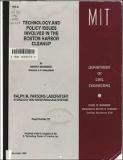| dc.description.abstract | Introduction: Throughout history, disposing of human wastes has been a problem. In the late 1800's, when communities began to flourish, it was generally believed that human waste was the source of many diseases. The principal method of disposal at this time was to discharge the waste into local waters - rivers, lakes, or the ocean. In the Boston area, the receiving water was the Boston Harbor. In the late-1800's, Boston's waste was combined with water, transported to Deer Island and Moon Island, chlorinated, and discharged into the harbor. In the early- 1900's, Boston's disposal method was considered innovative because wastewater from Moon Island was discharged only on the outgoing tide. By the mid-1900's, Boston realized that its method of wastewater disposal was beginning to adversely effect the water quality and aesthetics of the harbor. Primary treatment of the wastewater did not begin until the late-1960's when the Deer Island and Nut Island facilities were constructed. Due to Boston's rapid population growth, these primary treatment plants were obsolete the moment they began operation. Both plants discharge chlorinated effluent and chlorinated digested sludge into the President Roads area of the Boston Harbor. The sludge is still discharged only on the outgoing tide. Boston and some of its neighboring communities have a combined sewer system. This system transports both wastewater and stormwater to the treatment facilities. During periods of excessive flows, the combined sewers are designed to overflow into nearby waters - such as Boston Harbor and the freshwater rivers that feed the harbor. These discharges occur frequently (more than one hundred times per year) in the Boston area which results in an estimated overflow of 40 billion liters per year of wastewater and stormwater into the harbor. These overflows cause beach and shellfish bed closures throughout the area. The Clean Water Act (CWA), created in 1972 and amended in 1977, required all municipalities to provide uniform (secondary) treatment to the wastewater before releasing it into the receiving water. At this time, the federal government was providing funding for 85% of the construction costs for the secondary treatment facilities. In the amended act, a provision, under section 301(h), allowed municipalities the right to waive the secondary treatment requirements if they were discharging into marine waters through a long outfall. The Metropolitan District Commission (MDC), who at that time was responsible for providing treatment to the greater Boston area wastewater, believed that the benefits of secondary treatment were not justified. This was based on a number of studies that determined the priority of 52 projects related to the Boston Harbor cleanup. Secondary treatment ranked 4 3rd. Based on these findings, MDC applied for the secondary treatment waiver. It was not until nearly eight years after the enactment of the amended CWA that MDC was tentatively denied its waiver. During this time, nothing was done to improve the wastewater treatment facilities because no funding was made available during the waiver application process. Political tensions surrounding the Boston Harbor cleanup issues began to emerge and a new agency, Massachusetts Water Resources Authority (MWRA), was created. MWRA is responsible for providing treatment to the wastewater. When MWRA was established, there was strong political and legal pressure to cleanup the Boston Harbor. Due to this pressure, MWRA gave up its right to appeal the tentative denial of the secondary treatment waiver and began plans for the construction of a secondary treatment facility. The construction schedule consisted of consolidating the treatment process at a single location on Deer Island. The treatment process would provide primary treatment by 1995 and secondary treatment by 1999 of all MWRA wastewater. This schedule also included the construction of an outfall to transport the effluent 14 km off the shore of Deer Island, and to stop ocean disposal of the sludge. The estimated cost of this project is $6.1 billion. At this time, the funding by the federal government for the construction of secondary treatment facilities is no longer available; therefore, the burden of paying for these facilities is on the taxpayers. Ever since the enactment of the CWA, scientists have been questioning the need for disposing secondary treated effluent into deep coastal waters. This question has been the focal point of many debates on Boston Harbor. Although, an even more important question for the taxpayers and MWRA is - whether the $6.1 billion project will cleanup the harbor? This document summarizes the enormous amount of literature available on the technical and political issues related to the Boston Harbor cleanup. Chapter 1 and 2 discuss the physical aspects of the Boston Harbor and the existing treatment facilities. Chapter 3 addresses the technical and political issues that led to the decision to construct secondary treatment facilities. The components of the proposed secondary treatment facilities are discussed in detail in Chapter 4. The management of sludge, which is the residual byproduct of secondary treatment, is discussed in Chapter 5. Controlling the combined sewer overflows - a major source of pollution to the Boston Harbor - are discussed in Chapter 6. Chapter 7 discusses the modeling and monitoring efforts done to date and the efforts recommended for the future. Finally, Chapter 8 discusses alternate ways of approaching the cleanup. | en_US |
